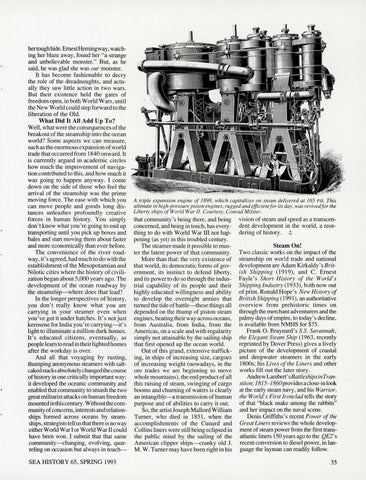her tough hide. Ernest Hemingway, watching her blaze away, found her "a strange and unbelievable monster." But, as he said, he was glad she was our monster. It has become fashionable to decry the role of the dreadnoughts, and actually they saw little action in two wars. But their existence held the gates of freedom open, in both World Wars, until the New World could step forward to the liberation of the Old. What Did It All Add Up To? Well, what were the consequences of the breakout of the steamship into the ocean world? Some aspects we can measure, such as the enormous expansion of world trade that occurred from 1840 onward. It is currently argued in academic circles how much the improvement of navigation contributed to this, and how much it was going to happen anyway. I come down on the side of those who feel the arrival of the steamship was the prime moving force. The ease with which you can move people and goods long distances unleashes profoundly creative forces in human history . You simply don't know what you 're going to end up transporting until you pick up boxes and bales and start moving them about faster and more economically than ever before. The convenience of the river roadway, it's agreed, had much to do with the establishment of the Mesopotamian and Nilotic cities where the history of civilization began about 5,000 years ago. The development of the ocean roadway by the steamship-where does that lead? In the longer perspectives of history, you don't really know what you are carrying in your steamer even when you've got it under hatches. It's not just kerosene for India you're carrying-it's light to illuminate a million dark homes . It's educated citizens, eventually, as people learn to read in their lighted homes after the workday is over. And all that voyaging by rusting, thumping anonymous steamers with saltcaked stacks absolutely changed the course of history in one critically important way: it developed the oceanic community and enabled that community to smash the two great militarist attacks on human freedom mounted in this century. Without the community of concerns, interests and relationships formed across oceans by steamships, strategists tell us that there is no way either World War I or World War II could have been won. I submit that that same community-changing, evolving, quarreling on occasion but always in touchSEA HISTORY 65, SPRING 1993
A triple expansion engine of 1898, which capitalizes on steam delivered at 165 PSI. This ultimate in high-pressure piston engines, rugged and efficient for its day, was revived for the Liberty ships of World War 11. Courtesy, Conrad Milster.
that community's being there, and being concerned, and being in touch, has everything to do with World War III not happening (as yet) in this troubled century. The steamer made it possible to muster the latent power of that community. More than that: the very existence of that world, its democratic forms of government, its instinct to defend liberty, and its power to do so through the industrial capability of its people and their highly educated willingness and ability to develop the overnight armies that turned the tide of battle-these things all depended on the thump of piston steam engines, beating their way across oceans, from Australia, from India, from the Americas, on a scale and with regularity simply not attainable by the sailing ship that first opened up the ocean world. Out of this grand, extensive trafficking, in ships of increasing size, cargoes of increasing weight (nowadays, in the ore trades we are beginning to move whole mountains) , the end product of all this raising of steam, swinging of cargo booms and churning of waters is clearly an intangible-a transmission of human purpose and of abilities to carry it out. So, the artist Joseph Mallord William Turner, who died in 1851, when the accomplishments of the Cunard and Collins liners were still being eclipsed in the public mind by the sailing of the American clipper ships-cranky old J. M. W. Turner may have been right in his
vision of steam and speed as a transcendent development in the world, a reordering of history. !, Steam On! Two classic works on the impact of the steamship on world trade and national development are Adam Kirkaldy 's British Shipping (1919) , and C. Ernest Fayle's Short History of the World's Shipping Industry (1933), both now out of print. Ronald Hope 's New History of British Shipping (1991), an authoritative overview from prehistoric times on through the merchant adventurers and the palmy days of empire, to today 's decline, is available from NMHS for $75. Frank 0. Braynard's S.S. Savannah; the Elegant Steam Ship (1963, recently reprinted by Dover Press) gives a lively picture of the development of coastal and deepwater steamers in the early 1800s; his Lives of the Liners and other works fill out the later story. Andrew Lambert' sBattleships in Transition; I 815-1860providesaclose-in look at the early steam navy, and his Warrior, the World's First Ironclad tells the story of that "black snake among the rabbits" and her impact on the naval scene. Denis Griffiths ' s recent Power of the Great Liners reviews the whole development of steam power from the fust transatlantic liners 150 years ago to the QE2's recent conversion to diesel power, in language the layman can readily follow. 35
